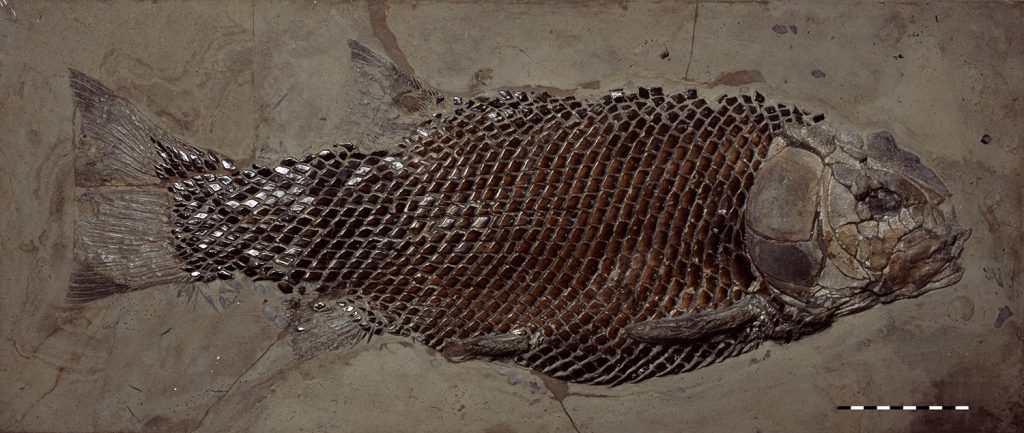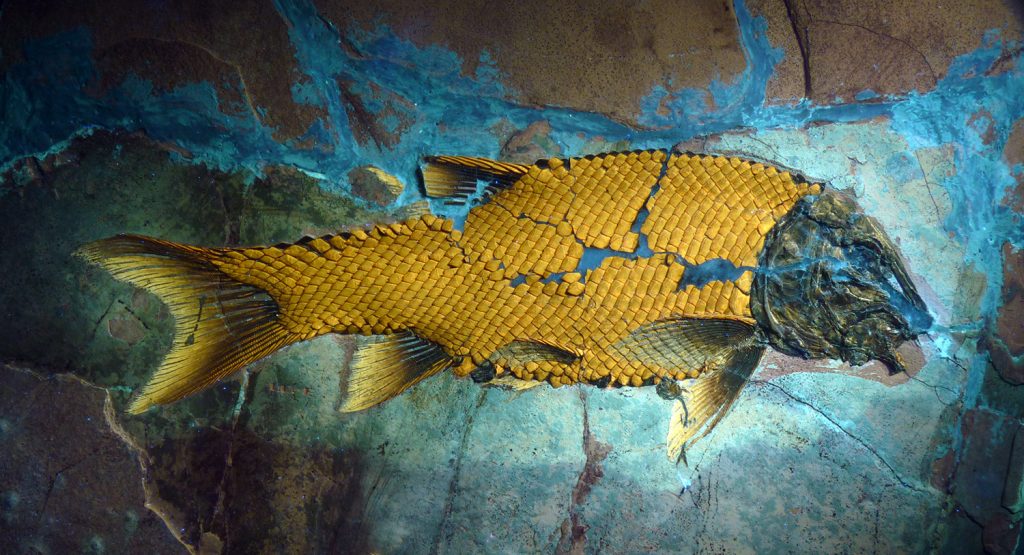A hard nut to crack: the Evolution of the armored fishes
Bavarian State Collection for Palaeontology and Geology
They ruled the oceans when the dinosaurs populated the continents: the armored fishes, members of the bony fishes that were armored with hard bony scales, the surface of which was covered with ganoin, a hard calcified substance resembling the teeth’s enamel, which reached up to one centimeter thick in large fishes. Many fossils of this unusual fishes are known from Mesozoic times, from the Triassic (about 230 million years ago) to the upper Cretaceous (about 70 million years ago), but their diversity and evolution have remained enigmatic so far. Researchers have traditionally been classifying most of these fossils in only two genera under the names Semionotus and Lepidotes have been used.
In an article recently published in the scientific journal PLoS ONE, Munich paleontologist Adriana López-Arbarello (Bayerische Staatssammlung für Paläontologie und Geologie) explored the evolutionary relationships of this important group of Mesozoic fishes. Her studies led to surprising results: not only were the armored fishes much more diverse than previously thought, but several of the known forms also turned out to represent the evolutionary lineage leading to recent gars. “The two genera Semionotus and Lepidotes have been like “wastebaskets” for Mesozoic fishes with thick ganoid scales”, explains López-Arbarello: “My work shows that these animals actually belong to different evolutionary lineages and the number of species as well as the ecologic adaptations are much higher than recognized so far.” Therefore, many of the species previously classified under these two genera needed new taxonomic names.
But not only these findings surprised the scientists. Many of the armored fishes of the Mesozoic turned out to be related to gars, a group of fishes that is today only known from seven species living in lakes and rivers in North America. “Whereas recent gars play a very minor role in comparison to the 27,000 or so species of modern bony fishes, their fossil relatives from the Mesozoic represented one of the most successful groups of fishes of their time”, according to López-Arbarello: “At that time, the relatives of modern gars filled many ecological niches, both in fresh water and marine environments, and this globally.
Although fishes are amongst the most common fossils and, with some 28,000 recent species, represent almost half of the known vertebrate diversity of our modern world, this group is still comparatively poorly studied. “Concerning the fishes of the Mesozoic, not only their evolutionary relationships, but in most cases even their species diversity remains enigmatic”, states López-Arbarello: “However, this is the time when most modern groups of fishes appeared, and a better understanding of the evolution of Mesozoic fishes would be crucial for understanding the origin of modern fish diversity!” The research was financed by the German Research Foundation (DFG).
Publication:
López-Arbarello A (2012) Phylogenetic Interrelationships of Ginglymodian Fishes (Actinopterygii: Neopterygii). PLoS ONE 7(7): e39370. DOI: https://doi.org/10.1371/journal.pone.0039370
Contact:
Dr. Adriana López-Arbarello
Bavarian State Collection for Palaeontology and Geology (SNSB-BSPG)
Richard-Wagner-Str. 10
80333 Munich
E-Mail: a.Lopez-Arbarello@lrz.uni-muenchen.de
Tel.: +49 (0)89 2180 6725
Lepidotes gigas Agassiz from the area of Holzmaden in the Palaeontological Museum Munich, Photo: A. López-Arbarello Macrosemimus fegerti, in the Jura Museum Eichstätt. The specimen was photographed under ultraviolet light, under which the fusion scales glow yellow. Photo: A. López-Arbarello



